






“They have an activities sheet every day with many many choices, so I think that’s very good too. Plus, housekeeping is terrific, and they do my laundry once a week and they fold it beautifully. Finally, the care staff here are attentive to me. They show attention. They show care. All in all, I would highly recommend Vitality Living St. Matthews!”
- Matthew Lemberger, Resident











PUBLISHER
COREY BOSTON corey@townepost.com (502) 407-0185
TRE'SEAN DURHAM GAVIN LAPAILLE
LINDSEY
MATHEIS MELISSA STALB
VITTITOE BETH WILDER MICHELLE T. WILLIAMS JULIE YATES
TOWNE POST NETWORK, INC. FOUNDER, CEO TOM BRITT tom@townepost.com (317) 496-3599 PRESIDENT JEANNE BRITT jeanne@townepost.com (317) 810-0011
PRODUCTION COORDINATOR ERIN TURK
CREATIVE DIRECTORS VAL AUSTIN TONI EADS
DIRECTOR OF DIGITAL SERVICES
DEVON DEAN
COPY EDITOR JON SHOULDERS
TOWNE POST NETWORK, INC. 8800 North Street, Suite 117 Fishers, IN 46038 Phone/Text: (317) 810-0011

CONTACT








Writer / Mary Lindsey


Imagine these situations: You’re a professional with a jam-packed daily schedule, and cooking dinner is the last thing you want to do when you get home. Or perhaps you’re a senior who wants to maintain independence and avoid assisted living, though your kids worry about you cooking every night. Maybe you’re aiming to shed a few pounds and wish you had a personal chef to make it easier. A busy parent who struggles to prepare healthy meals for the whole gang? You want your meals to be nutritious, fresh and healthy, but the thought of studying ingredients, counting calories, shopping and cooking is overwhelming.
This is where St. Matthews-based Home
Cuisine steps in. Celebrating its 20th anniversary, Home Cuisine was established to offer clients the convenience of a personal chef. The meals are both delicious and healthy, with calorie counts already calculated, leaving customers with the simple task of heating and eating.
The concept is straightforward, but surprisingly, no one had thought of it locally before Louisville foodie Sandy Pike had her eureka moment in 2004, when her sister faced health issues and couldn’t cook. Thus, Home Cuisine was born, emphasizing locally sourced, nutritious meals delivered to customers’ homes or convenient pickup points at all Rainbow Blossom stores.
Making it easy is just part of the mission. Sandy emphasizes that taste and quality are paramount.
“Our food is clean and tastes great,” she says. “Food prepared long in advance, like the national brands, needs preservatives to stay fresh, so our meals are delivered just
hours after preparation. That local, fresh twist allows us to offer a product that can’t be touched by big-box services cranking out thousands of frozen meals from a warehouse somewhere.”
The idea quickly proved successful, and within a few years, Sandy’s daughter, Mae Pike, returned from wedding planning in Florida to handle marketing, allowing her to focus on the culinary side. Over time the company expanded its offerings from just daily meals in two calorie ranges to various meal plans, including family-size dinners that Mae calls “a godsend for busy families who are tired of ordering pizza or hitting the drive-through.”
Subsequent additions have been equally popular, including holiday dinners, Derby brunches and dinners, and three-day cleanses, offered monthly.
“Thanksgiving went wild and has been our busiest week of the year for a long time,” Sandy reports. “It turns out that having a

fully prepared, traditional turkey-and-allthe-classic-trimmings dinner, delivered to your door, is really popular in Louisville.”
“Who wants to fool with cooking when friends and family are around?” Mae notes. “We do the hard part for you.”
With the company’s growth, the Pikes recognized the need for more hands on deck. Mae’s husband, Allen McKamie, left his career in hospitality management to become the CEO, while her sister, Elizabeth Kristofek, a certified holistic nutritionist, took charge of health and nutritional basics.
“We were so lucky to woo Allen and Elizabeth to Home Cuisine at a time of so much growth,” Sandy says. “Allen has a strong business background and helped us build our operations in ways that Mae and I always struggle with. Elizabeth has an almost encyclopedic knowledge of nutrition, and has pioneered the 3-Day Reboot as well as answering our nitpicky questions all day long. Plus, it’s nice having all of this youthful energy in the office. I absolutely love these kids!”
Lately, Home Cuisine has also grown an impressive wholesale division, pioneered by McKamie. “We prepare products for local institutions, following their recipes, to be packaged as their resale, and it works out really well,” McKamie explains. “We also provide bulk meals for local institutions that need to offer meals for their staff or clients, but don’t want the expense or hassle of a full-tilt kitchen. The feedback has been really positive and we look forward to expanding.”
The company’s latest innovation is Dinner Party in a Box, which caters to those who love entertaining, but not the planning and cooking.
“We’re inviting customers to imagine dinner

in Paris with a French menu, Charleston with Lowcountry fare, and San Francisco with the menu planned around an evening in North Beach,” Mae says. “And the concept is evolving; now we’re developing

a wonderful Local Dinner Party in a Box, featuring classic Kentucky regional delicacies, that we hope to introduce late this fall. Online ordering makes it a breeze to host a lovely party without scrubbing one

Belmont Village’s Circle of Friends Program was developed to slow the cognitive decline associated with Alzheimer’s Disease and other forms of Dementia. This one of a kind, seven day a week program includes mental and physical activities focused on building cognitive reserve to maintain brain function.
If you think this program might benefit your loved one, don’t hesitate, contact Belmont Village St. Matthews today.
BelmontVillage.com/StMatthews | 502-721-7500

pot. What a great time to crack out the fine china and actually enjoy your guests!”
So far, Dinner Party in a Box has been well-received. That’s not a surprise, Mae says. “To test the meals, we pulled them out of my mother’s refrigerator for Pike family gatherings. The menus were so effective that everyone raved - and it was nice knowing that mom had been relaxing that day, not running around making all of us dinner. My family is a tough audience and everyone was impressed.”
The reputation they now enjoy, Mae adds, has been a group effort. “We’ve been blessed with an amazing staff,” she says. “To name a few, Kathy Robinson, our kitchen manager, came to us in our panic during the pandemic, and we were so lucky to keep her. Chip McPherson is truly one of the most gifted chefs. I learn something from him every time I am in the kitchen. He’s an old friend; we met at Deitrich’s in the ’90s when I was a server and he was the chef. After years of begging on bended knee, he finally
agreed to come work with us, and our food has never been better. He makes me so proud of our product.”
Although the business started modestly, with just one employee and a tight budget, its success was no accident. Sandy’s previous ventures provided plenty of experience. She founded Jack Fry’s and turned it into a favorite in Louisville before selling it in 1986. Then she created Cafe Society in what is now NuLu, and Louisville’s first dessert cafe, The Queen of Tarts, proving her ability to identify and fill a niche market. Then came Home Cuisine, which she launched by renting a small corner in the kitchen at the Mayan Café, which remains a family favorite.
“Now we have this huge commissary in St. Matthews,” Sandy marvels. “I never imagined this growth, but I’m proud we’ve made it here.”
“I’m so proud of my mother and her accomplishments,” Mae adds. “In the 1980s

she was doing things that no one else in town had thought of, and with her drive and talent, she broke so many glass ceilings. She just seemed to be writing, or rewriting, the rules as she went along. I’ve learned this entire business from her, and I love to brag about her.”
Sandy, meanwhile, is looking ahead. She sees a gradual transfer of leadership to the next generation, with Mae, Allen and Elizabeth poised to ensure the company’s future.
And Mae’s passion mirrors her mother’s. “We get up every day to hear stories of people getting off their blood pressure meds, no longer being prediabetic, reducing their medication - or just that we make things easier for them,” Mae says. “It’s immensely rewarding to know our meals make such a difference in people’s lives.”
For more info, explore homecuisineonline.com.








As the leaves fall and the air turns crisp, it’s the perfect time to slow down and savor moments with the ones who matter most. Whether gathering around the table or enjoying the beauty of the season, make time for family and create memories that will last a lifetime.



Writer / Dave Matheis

It is the time of year to honor the veterans of the United States military for their service. Here is the story of one of them.
My father, Stephen Carlos Matheis, was inducted into the service on September 15, 1941, a few months before the United States entered World War II. According to his draft registration, he was working at Wood Mosaic, a factory close to the L&N (Louisville and Nashville) Railroad yards in Highland Park, a working-class neighborhood in South Louisville that was demolished in the 1990s to make room for airport expansion. His father, Stephen

Louis Matheis, was also working there and had been for a bit more than 10 years. He had worked for L&N up until 1929. He was part of a strike that year, not long before the Great Depression hit in October. The strikers were fired. A few months later, he lost his house. A few years later his marriage ended.
Having been accepted for active military service, my father was immediately sent to Fort Thomas, Kentucky, to await orders. He was shortly assigned to a New York National Guard unit which had been federalized into the regular Army to become the 27th Army

Division. It was supplemented with draftees mostly from Kentucky and Indiana. During the fall of 1941 and the winter of 1942, the division trained in Alabama and Texas. It became the first Army division to leave the United States for the Pacific Theater after Pearl Harbor, departing from San Francisco in March of 1942. My father would not return to the United States until October of 1945.
The division went directly to Hawaii. It remained there on garrison duty, awaiting further orders for 18 months. It then became one of the few Army divisions attached to the island-hopping campaign through the Central Pacific with the ultimate goal of attacking the Japanese home islands. The battles of this campaign were chiefly fought by the United States Marines. My father was in the 165th regiment of the 27th Infantry. He was in Company H, a heavy weapons company, and assigned to water-cooled machine guns. Gradually he was promoted to staff sergeant.
His first battlefield action was in November of 1943 when the 165th regiment was detached from the 27th Infantry Division to capture the atoll of Makin, which contained a small Japanese defensive garrison. While the 165th was accomplishing its objective, a Marine division was to take nearby Tarawa, where there was a much more formidable Japanese force. Tarawa became the biggest island battle of the war to that point, ending in a resounding Marine triumph. The 165th was expected to capture Makin in one day but took three. The green troops faced much stiffer-than-expected resistance from the Japanese.
In the Pacific Island battles of World War II, the Japanese soldiers were expected to fight to their last breath, to die for the emperor. They resisted fiercely until the very end of every island battle. Surrender was not an option. After the first few battles, the Japanese learned quickly they could not successfully defend the invasion of beaches because of superior American firepower. Their strategy became one of attrition. They would wait for the Americans in the island interior and try to kill as many of them as


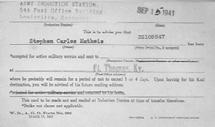




possible. Battles usually became slow, grinding, bloody affairs. Almost all island battles ended with a banzai attack in which the remaining Japanese forces would make a suicidal rush on American lines at night.
After Makin, the 165th regiment rejoined its division in Hawaii. The 27th Infantry began preparing for the invasion of Saipan. The island of Saipan had been a Japanese possession before the war. The islanders considered themselves Japanese citizens. The battle would be the first fought on what was essentially Japanese soil. For this reason, even stiffer resistance was expected.
On June 15, 1944, the 2nd and 4th Marine Divisions established a beachhead on the western shore of Saipan. The 27th Infantry was then brought ashore to become the middle division of a three-division front that would advance across the island. The Marines and the Army were trained differently. Marines were trained to take their objectives at all costs. Army troops were trained to keep casualties as low as possible while advancing. This difference in training became quickly apparent at Saipan. The 27th Infantry could not keep up with the Marine divisions, causing the line to form a “U” shape and exposing the Marines to flank counterattacks. The Marine general in overall charge of the invasion force replaced the 27th’s commanding general. His replacement was able to get the division to advance faster to straighten out the American line of attack.



By early July, the American forces had surrounded the Japanese defense forces in the northeastern corner of the island. The Japanese staged their banzai attack. After that was defeated, the island was captured. The Battle of Saipan was notorious for what happened as it ended. As mentioned earlier, the island’s natives were Japanese citizens before the war. During the battle, the Japanese soldiers had spread rumors about the atrocities the Americans would commit if the island fell. Out of fear, more than 1,000 islanders committed suicide, mainly by jumping off cliffs into the sea below. About 3,200 Americans and 25,000 Japanese soldiers died at the Battle of Saipan.
After the Battle of Saipan, the 27th Infantry was sent to Espiritu Santo, a small French-controlled island off the coast of Australia, to train for the Battle of Okinawa, which would become the climactic battle of World War II. The battle began on April 1, Easter Sunday, as my father once told me. The 27th Infantry was once again brought on shore after a beachhead was established, and was inserted into the right side of the line that would advance on the southern half of the island where most of the Japanese resistance was located. After difficult fighting throughout the month of April, the division was taken out of the frontlines and sent to garrison the mostly pacified northern half of the island. Japanese resistance on Okinawa ended at the end of June. Over 12,000 Americans had died in the battle, along with over 94,000 Japanese soldiers and







thousands of civilians.
My father’s division was slated for the planned invasion of Japan itself. One million American casualties were anticipated from the invasion. It, of course, never took place. The Japanese surrender following the atomic bomb attacks on Hiroshima and Nagasaki. My father returned to the states in October of 1945 after three and a half years overseas. He was honorably discharged on October 15, 1945, from Camp Atterbury, Indiana.
But the war left its mark on him for the rest of his life. His memories of battle, atrocities (on both sides), and friends dying in the night haunted his dreams. He had what today would be called posttraumatic stress syndrome. More than 20 years after the war, he spent three weeks in a mental hospital. Although he did not make the ultimate sacrifice, like the more than 400,000 Americans who did in World War II, he still paid a heavy price, like untold thousands of soldiers across all the wars this country has fought.
Thank a veteran today.


GRATITUDE IN ACTION: EMPOWERING LIVES YEAR-ROUND: ZG Group proudly announces that we support over 250 individuals through our diverse services. Reflecting on October Disability Awareness Month, we are grateful for your commitment to ENRICH, EMPOWER, EDUCATE, and EMPLOY those with disabilities.
Our Year-Round Impact:
• Comprehensive Programs: From AVENUEZ to ZoomWorkZ, we offer various programs tailored to meet individual needs.
• Fostering Independence: Our initiatives focus on promoting independence and facilitating meaningful experiences and employment opportunities.
• Building an Inclusive Community: We strive to create a supportive environment where everyone can thrive.
Show Your Gratitude, Get Involved:
• Donate - Your contributions help us expand our services and reach more individuals.
• Volunteer - Share your time and skills to impact our community directly.
Together, we create opportunities every day. To learn more about us and how you can make a difference, visit thezg.us, email hello@thezg.us, or call 502.581.0658.


$5,000-$24,999.99
Minimum balance of $5,000 to obtain APY
Minimum balance of $25,000 to obtain APY
*Annual Percentage Yield (APY) is accurate as of 08/12/2024. Fees could reduce earnings on account. Rates are subject to change after account is opened.
*For new accounts at Louisville location only. 5 MONTH CD • 4.75% APY*
(Penalty for Early Withdrawal / $500 Minimum Balance)
*The Annual Percentage Yield (APY) is accurate as of 08/12/2024.
*For new accounts at Louisville location only.










Writer / Melissa Stalb

Wyn Ericson of Louisville was recently named first-place winner in the International Watercolour Masters 2024 Contest.
Last fall he submitted a portrait of his wife Chelsea, but couldn’t imagine the results that transpired.
“It’s like the Olympics,” he said. “They’ve been holding these shows every two years
for the past six years and it’s continuing to grow. I submitted a piece and didn’t think much about it.”
A few months later he received an email stating he was in the top 200 submissions across the globe.
“That was cool by itself, but a month after that I got another email that said 22 masters judged the submissions,” he said. “They
didn’t know whose work was whose, and they used this specific formula for judging. There were 10 first-place winners out of 4,567 entries and I received first place.”
In addition, Ericson was asked to be a part of a live show, demonstrating his work alongside other master artists.
Before he knew it, Ericson and his wife were standing in Lilleshall Hall, an estate in


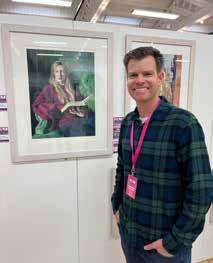




Shropshire, England, conversing among some of the most renowned artists in the world. The international exhibit was on display and an awards ceremony was the icing on the cake.
“It was an amazing experience and was really surreal,” he said. “It was mind blowing. They have a wine and cheese party in what’s virtually a castle, and we’re standing around these


beautiful gardens. I didn’t know all of the masters but now we’re friends and we’re following each other on social media.”
They share demonstrations, future art show information and general encouragement in the art world.
“When you do something for hours and hours a day and you’re putting yourself out there, you don’t know what will happen,” Ericson said.
The experience was a huge confidence boost and validation of Ericson’s skill - something all professionals appreciate as they continue to improve their craft.
“You go your whole life trying to make that shift from, ‘Am I good at this?’ to ‘Wait a second, I just won this huge recognition,’ and I’m speechless,” he said. “It gives me chills.”
His life has been surrounded by art, but he

wasn’t always so confident.
Ericson’s father was a middle school art teacher and he recalls going to the mountains, painting landscapes with his dad on the weekend and attending museum exhibitions. Like his father, Ericson became an art teacher, but after 15 years in the classroom he decided to take a leap of faith to become a full-time artist.
He’s worked with acrylics, oils and other mediums, and eventually landed on a love for watercolor painting.
“There’s an ease to watercolor,” he said. “You can manipulate it and you can take it wherever you go. It’s low maintenance and there’s no fumes.”
For the past five years Ericson has entered various shows, placing among the top of the entries.
He’s a member of the National and


This Creole Champion of St. Matthews, Lou Lou Food & Drink has thrived for years by delivering Louisville’s Louisiana connection in culinary delight. The New Orleans vibe is also alive at Lou Lou on Market.
The Lou Lou tradition continues in Middletown with our new location. 12717 SHELBYVILLE RD (502) 208-0882




American watercolor societies, and continued to push for growth and development in his craft.
While he finds landscape pieces enjoyable, he’s not one to shy away from a challenge, and in an effort to accomplish something new, he set his sights on portrait painting.
“It’s challenging but I’m one of those guys who has to figure it out,” he said. “I started doing portraits of my children and my wife. I’m self-taught in that area. I haven’t taken any portrait workshops. I want to continue to challenge myself and improve.”
Portraits can provide options for artists. For example, some prefer to paint portraits with a broad brush, blurring the lines of facial features and details, while others enjoy the challenge of making the piece look as realistic as possible. Ericson falls into the latter category.
“I’d call it realistic representationalism,”

he said. “I love going into the textures and fibers to create something hyper-realistic. It’s fun to be unpredictable sometimes, but I enjoy the lifelike qualities, the likeness and the connection that come with detailed portraits.”
He paints from photographs, and it often takes 45 to 60 hours per portrait, particularly when he’s going for an extremely detailed piece.
“It’s a fun challenge and I was originally inspired by wanting to have my kids’ portraits done,” Ericson said. “I’m watching them grow up so fast. Between a lot of faith on my wife’s part and the kids’ support, I’ve been so blessed to be able to do this.”
His three children are beginning to learn watercolor too. They recently took Ericson’s online course for new artists - something he created out of his passion for supporting beginner artists.
He interviewed 75 beginner watercolor artists to create a course that encourages and inspires.
“The results across the board were similar,” he said. “They’re scared of rejection - of things not turning out just right. Someone might see their horrible mess-ups. It was really enlightening. There’s no overnight success. I love it but it can take a toll on you. I try to get better every day and it’s important to be able to say, ‘I messed up today but I’ll do better tomorrow.’”
Ericson believes anyone who truly wants to become an artist can do so, if they have good teachers and aren’t too hard on themselves.
They say it takes 10,000 hours of anything to become an expert.
“You have to really want it,” he said. “I think if you are willing to experiment and try different things, you get a little hooked.

We test it out, make you an offer and CUT YOU A CHECK ON THE SPOT.


Then you have the curiosity factor and you’re able to push through that one you think looks horrible. I want my course to help people and I’m getting feedback like, ‘I’m not afraid to show my work now,’ and that’s the goal.”
Defying the naysayers, working full time as an artist, and continuing on his quest to improve and submit his work for the world to see, Ericson is still setting new challenges for himself. The commission work is coming in and he’s doing everything he can to put himself and his work out there, while continually learning and honing his skill.
“I won first place in 2022 and 2023 at the Urban Paint Out in Louisville,” he said. “I plan to enter the Portrait Society of America show. It’s one of the biggest national competitions. I just want to continue to further myself and build my following.”
He offers original work and prints online, as well as a membership program to
have prints (high-quality reproductions) delivered to your door each month. He’s accepting commission work for portraits, and is continuing to improve the online course for beginner watercolor artists.
It’s been a long road of ups and downs for the professional artist, but there’s something to be said for chasing dreams and working toward lifelong goals.
“I don’t feel like I’m working,” he said. “The days go by so fast. There were so many that told me to stick with teaching, but I really felt like I could do this. I did do it, and on an international scale, and it’s amazing.”
Learn more at wynericson.com, or follow Ericson on Instagram and Facebook. His online course can be found at ericsonartacademy.com.
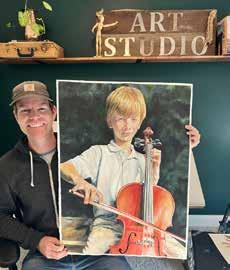





•
•
•
•







ACROSS
1. Gulf war missile
5. Like an enthusiastic fan
9. Boxing maneuver
12. Cut down to size
13. Antler’s point
14. Flamenco shout
15. Divorce alternative
17. Outfield surface
18. Business orgs.
19. Smooths
21. Fizzle, with “out”
24. House adjunct
26. Poetic paean
27. Card game start
29. Small amounts
33. Grazing ground
34. Gratifies
36. Break
37. Nothing but

DOWN
1. Aromatherapy site
2. Is up to the task
3. Coffee holder
4. Two-spots
5. Bill producers
6. C’est la ___
7. Hostel
8. Block or dissuade
9. Incense stick
10. Soothing plant
11. Flower plots
16. Christmas song
leapers
20. Elaborate
21. Equestrian contest
22. Heaven on earth
23. Pond swimmer
24. “Bullitt” director
39. Doctor’s directive
Colorway #8 - Member Colors
40. Age of Aquarius, for one
41. Needs treatment
43. European viper
45. Extinguishes
48. Kind of flour
49. Half and half
50. Highflying industry
56. Dawn discovery
57. During
25. Pub pints
28. British noble
30. Became mellow
31. Plain
32. Practice in the ring
35. Doesn’t go
38. Bark
42. Biblical patriarch
44. Stop
45. Extinction exemplar
46. Again, in different form
47. Whimper
48. Was a passenger
51. Flightless bird
52. Barbecue offering
53. Make like
54. Game show giveaway
55. Glade shade
58. Australian export
59. Mouse catcher
60. Die
61. Duration of office
Solution can be found on the magazine Facebook page



usicians sometimes take unusual measures in order to create the specific sounds they have in their minds. Other times, they experiment to just see what happens with sound. For example, Icelandic musician Björk had engineers build gravity harps for her Biophilia tour. Pat Metheny created a 42-string guitar. Members of the 1970s band 10cc created the Gizmotron, a blend of a guitar and bass that makes violinlike sounds.
Louisville musician Bruce Krohmer is also guilty of creating his own instrument (a half-clarinet that he plays with a full clarinet), but he is also known for playing just one clarinet in an unusual place: a standpipe.
What is a standpipe, you ask? Its most basic definition is a vertical pipe that helps ensure stable pressure in a water-supply system. If you research images, you will see all kinds of vertical pipes, but these are all quite small. The standpipe that Krohmer has recorded

in is huge, standing at around 165 feet, and it is surrounded and protected by an even taller iconic tower that was designated as a National Historic Landmark in the early 1970s. This tower is one you can see every time you drive on or past River Road at the intersection of Zorn Avenue.
According to a 2016 article by Joe Holleman from the St. Louis Post-Dispatch, these standpipe towers used to be found in many places, numbering into the hundreds, and






were scattered across the United States in the late 19th and early 20th centuries. Now only seven remain, and one of them is the Louisville Water Tower. It is, in fact, the oldest one, built in 1860.
While the tower’s architecture itself is beautiful, what it encloses - the standpipe - is very utilitarian. In a write-up about the restoration of the tower on its website, the Louisville Water Company noted that the standpipe “helped control the force of giant steam engines that pulled water from the Ohio River for Louisville Water’s operations.”
Krohmer first had the idea to record in the standpipe in the late 1980s and early 1990s when he attended a music festival on the tower grounds and was able to get access to play in the standpipe. “I stood 38 feet off the ground and played clarinet for two hours,” he says. “I was playing mostly Bach because it worked really well with the reverb in there. It sounded like I was playing three clarinets at once. Even though it is a tall place, it is not very wide, so sound bounces back really quickly.”
He moved out of Louisville for several years, but





when he returned he asked the Louisville Water Company if he could play in the standpipe again, and didn’t have any success. After about six years of pleading his case to play in the tower again, he got his wish after the space was completely renovated. “It took me about 14 years to get back in there to make this recording,” he says. “I guess they just got tired of telling me no.”
While he originally played Bach in the standpipe, he mixed up the music for his most recent session, which included recording. “Now I have more of my avant-garde music along with songs from the 1830s,” he says. Two of the songs Krohmer played were composed by William Cumming Peters, a man who opened the first music store in Louisville in 1832. Recording in the standpipe only took about four hours, and was expertly recorded by sound technician Howie Gano.
While playing music in a standpipe may sound odd, it is only one of the memorable
experiences Krohmer has had since being bitten by the music bug and learning to play in elementary school.
He began his music career with the clarinet, and his reason for selecting it is fairly endearing. His older brother played oboe with the University of Louisville orchestra. “I saw him practicing his oboe around the house so I picked out the clarinet because it was the only thing that looked like his oboe,” Krohmer says.
When he decided to learn to play the saxophone, though, his reasons were a little more practical. “My teacher, Mr. Markert, said, ‘If you want to make money and you’re going to play a reed instrument, learn to play the saxophone because there are lots of gigs with saxophones,’” he says.
After Krohmer’s father died and his mother returned to full-time work, he would hang out after school at the St. Matthews Eline library until his mother got off. It was there



that he spent hours listening to jazz music. “I listened to every record they had,” he says. He recalls buying a John Coltrane album at age 11 from Webb’s Drugs on Hubbards Lane.
At age 13 he had gotten a Woody Herman album after joining the jazz club, and was able to see the band perform at Black Expo in downtown Louisville. “At break time, I went up and talked to him,” Krohmer says. “I walked with him, his pianist and his lead trombonist, and talked to them for about 20 minutes during their break, absorbing all this stuff.” It was at this age that he joined the Louisville Civic Orchestra.
Around two years later, Krohmer was able to hear one of his favorite musicians, Roland Kirk, a blind musician who plays three saxophones at once. “He has two special saxes that he picked out of pawn shops and modified a little bit,” he says. Bruce went to 114 West, a jazz club of the time. “I sat on the steps outside the club and listened



to him play,” he says. He loved not only Kirk’s music, but also his sense of humor and his ingenuity with adapting instruments to make unique sounds.
Though jazz was his first love, as Krohmer got older, his musical life grew more varied. He co-founded Kentucky Homefront Performances, a radio and live show, with John Gage, and played in numerous bands. “I played with the Merseybeats U.S.A. and with two retro country bands, the Falls City Ramblers and the Buzzard Rock String Band,” he says. When he lived in Maryland, Oktoberfest was a big event, so he played in those types of polka bands for a long time. He has played with some klezmer bands, which he says is fun because you have to make the clarinet chirp. He played with a progressive rock group called French TV on their second and third albums. Plus, over the years he played stints with the Louisville Orchestra and as an Actors Theatre pit musician.
So what is next for this experimental musician? Since making the standpipe recordings, he has been busy working to put the finishing touches on songs in postproduction and figuring out how he wants to distribute the recordings. And after that? Well, if his musical history is any indication, it will be something unexpected.
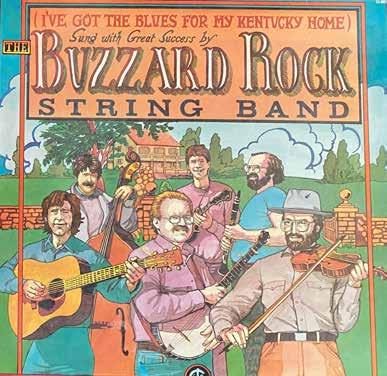

Writer / Julie Yates

November 14 is your opportunity to support a great cause…and have fun doing it!
For the fourth year, Belmont Village Senior Living will host An Art Affair, a fundraiser to benefit St. Matthews Area Ministries (SMAM). The event is an example of how area partnerships and cooperative efforts can provide for the needs of the community.
This special evening is all about art, music, entertainment and refreshments, and it’s all for a worthy cause. Only local Kentucky and Louisville artists are invited to participate. A wide variety of art forms are represented including wood, metal,
ceramic, glass, and a variety of painting types. The artists enjoy participating because it gives them an opportunity to reach a new and unique audience, sell their work and know they are supporting a good cause. All money raised during the evening goes directly to SMAM programs, which aid those needing assistance with rent, utilities, clothing and food. It’s going to be a fantastic event that supports the community in a meaningful way.
“St. Matthews Area Ministries is a 501(c) (3) nonprofit organization that began 52 years ago,” says Julie Abbott, St. Matthews Area Ministry Executive Director. “It is not a church, but one of 13 community
ministries in the city of Louisville. In 1972, three churches came together because they saw people in need. Today member churches and other organizations, as well as businesses, work together to provide a wide range of services such as emergency financial assistance, a food pantry, homebound delivery, infant and toddler items, school supplies and much more.”
The idea of An Art Affair is to support both local artists and SMAM. The first floor of the facility is transformed into an artistic showroom where attendees can meander through the various artistic offerings and purchase items of interest. Guests are treated to a lovely array of hors d’oeuvres

and a wine bar - and to cap off the evening, a chocolate fountain with a variety of fruit and other food to be dipped in the decadent warm, melted chocolate.
The November date, being close to the kickoff of the holiday season, lends itself to gift buying.
“We try to have a good variety of artistic mediums, and our goal is to have between 14 and 20 artists from Frankfort, Lexington and Louisville,” says Erika Kerins, director of community relations for Belmont Village Senior Living. “This year we have both new artists and some that are returning. The event is set up to have a good flow with







plenty of space between artists. Another aspect of the fundraiser is a silent auction.”
Bidding can get lively and competitive on the unique items. Securing these items requires meticulous planning and often takes several months. Kerins notes that numerous local businesses generously donate a variety of items, and there are also contributions from artists who, despite being unable to participate in the show, graciously provide pieces for the auction.
An added treat is the opportunity to participate in bourbon tasting. Dr. Jerry O. Dalton, 2023 Kentucky Bourbon Hall of Fame inductee, will share facts and local lore about the samples provided. Dalton earned
his Ph.D. in chemistry from the University of Louisville and has the distinction of being the only non-family member to serve as master distiller for Jim Beam. After being in the position from 1998 to 2007, he trained Jim Beam’s great-grandson, who then took over Dalton’s job when he retired.
“There has been ongoing support and cooperation between SMAM and Belmont Village,” Kerins says. “Right after COVID we started talking about different possibilities that would work well as a fundraiser. None of us had a real solid concept but we knew we wanted to do something with the arts, and this evolved. A graphic designer from one of the area partner churches designed the logo. The artists pay a booth fee and











the first year it was hard to get artists lined up. Now, since we have done it before, it is easier. Each year we tweak the event to make it better, and our goal is to have it grow.”
“Originally SMAM had a huge senior focus, but during these times it is coming full circle,” Abbott says. “We have learned that since the pandemic, we need community partnerships, and we can’t do anything without volunteers. People have needs 365 days a year, so we must step out of the box and introduce the ministry to the community. The ministry has no budget for promotions, which makes us appreciate this unique collaboration.”
The programs of SMAM benefit all ages and, as a result, strengthen the community. It works with Louisville Gas & Electric and Louisville Water to provide financial assistance with utility bills. It offers essential items for infants and toddlers such as diapers, wipes and other gently used items. School supplies, including those needed for
preschool, are distributed the first week in August each year. These are available as the school year progresses until items run out.
The food pantry programs are made possible by the generosity of the community and a valued partnership with Dare to Care Food Bank. Each month deliveries are made to homebound individuals. During the holidays, the organization spreads joy with seasonal baskets distributed at Easter and Thanksgiving. Hams are given out at Christmas.
“An Art Affair really is a fun night,” Kerins says. “The tickets are only $25 and attendees are getting so much. The event is a nice evening out - just three hours - but there is so much packed into it, and we offer free valet parking.”
The location for An Art Affair is Belmont Village Senior Living, at 4600 Bowling Boulevard in Louisville.
SMAM is housed within St. Matthews Methodist Church at 319 Browns Lane in Louisville. To seek assistance, individuals must call 502-893-0205 on Monday, Tuesday or Thursday between 9 a.m. to 2 p.m. Services are by appointment only.
Volunteers and donations, both monetary and in-kind, are always needed. For information, visit stmam.com.
Tickets for An Art Affair are available for purchase at stmam.com/an-art-affair.










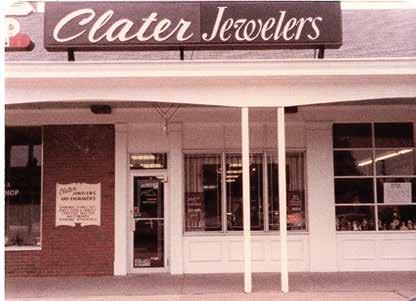
Writer / Gavin LaPaille
Clater Jewelers was founded by William D. Clater in 1949. After service in the Navy, he attended American Watchmakers Institute, and opening a jewelry store seemed like a natural next step.
Sallie Clater Baer, daughter of William Clater, and Megan Campbell Martin started working in the jewelry store in 1973, and both celebrated 51 years in the business this year. Baer and Martin have owned the store for 27 years. “Mr. Clater was a kind and wonderful, caring man,” Martin said. “Sallie and I were young when we started working for him and he instilled high ethical standards in both of us.”
Christy Martin Effinger, daughter of Megan Martin, graduated from the Gemological Institute of America in October 2009. Effinger’s position as a graduate gemologist has allowed Clater Jewelers

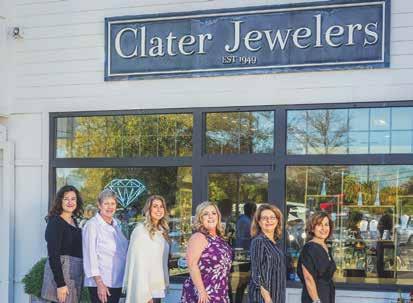
to offer many services to the store. Along with Lynn Stahl and Shannon Waits, both 30-year employees, plus the jewelers, Clater Jewelers has over 200 years of experience.
“In our business your word means everything,” Baer said. “The more educated and informed we are, the better we can serve our customers.”
As the only member of the Independent Jewelers Organization in Louisville, Clater Jewelers has access to the largest independent jewelry buying group in the world.
Clater Jewelers is dedicated to maintaining the highest standards of ethics, knowledge and customer service, and they have fun doing so. “We have so much fun going to jewelry shows, curating new collections and shopping for our customers,” Effinger said.
In addition to helping a customer select the
perfect piece of jewelry, they also emphasize how important it is to care for and clean your new piece.
Whether it is an engagement ring, anniversary present, birthday gift, or even a custom-made creation, Clater Jewelers has played a role in many unforgettable moments.
Sallie and Megan are committed to Clater Jewelers’ customers, their community, and continuing a sparkling legacy.

Writer / Julie Yates

Bringing Justice Home is a nonprofit organization committed to alleviating hunger caused by food insecurity for those facing disabilities and chronic or serious illnesses.
Now in its fourth year, the completely volunteer-run initiative seeks to facilitate food justice by delivering groceries and household supplies to health-compromised families and individuals who fall below the poverty line. Equally important is the relationship building that occurs as resources are shared and volunteers open their hearts to bringing justice closer to home.
Recipients of the services the organization provides are called neighbors rather than clients. The idea denotes an equal playing field, thus taking away stigma of having to ask for help. It promotes the concept of interdependence where all are equally valued.
“Bringing Justice Home is a new kind of neighborhood that goes beyond zip codes, race, disabilities, health labels or status,” says Constance Merritt, who co-founded the organization along with her wife, Maria Accardi. “It was begun at a time of uncertainty, during the pandemic. Food pantries were closed, and although there were places people could pick up meals,
often they were unable to get there. ‘Healthy at home’ became ‘hungry at home’ for many.”
“Maria and I knew that a need existed, and we wanted to do something,” she adds.
“One night we were washing dishes and I half-jokingly said, ‘Should we open up a food pantry in our scary basement?’ We knew we wanted to open a nonprofit, so we reached out to friends.”
Merritt and interested friends reached out to three local food pantries to see if they could find space to use that was climate controlled and secure. None had any room available. Finally, the thought emerged of picking up
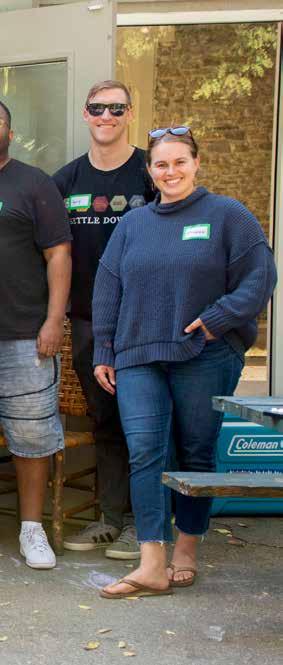



orders directly from Kroger and delivering from there.
Today, four out of the five current board members have been involved in food ministries of area churches. All wanted to do more, including developing a more personal touch than just a traditional food bank. Currently, there are three ways Bringing Justice Home serves the neighbors in their community: a monthly food delivery, a sponsored membership in a community-supported agriculture program, and a biannual delivery of pantry staples.
“Our neighbor advocates take the orders to be placed on the Kroger website for the








customized monthly deliveries,” Merritt says. “They develop a relationship with their assigned neighbors who are dealing with varied health issues and may want to watch their sugar or salt intake. Pet food and household supplies are also available. The advocates might ask, ‘Are you sure you want to order this? It has 900 milligrams of sodium.’ The recipient is usually glad for that information and might adjust their order.”
“Currently we serve 52 families,” she continues. “Some make barely $700 a month, which is not enough to make ends meet. We partner with Barr Farms’ community-supported agriculture program, and biweekly neighbors get a box with five to seven organic items. Although we hope to do it quarterly, right now household staples deliveries are every six months. We use Walmart to deliver these pantry supplies.”
To become a neighbor in the Bringing Justice Home community, a form is available on the organization’s website.
Many are referred from agencies or a person who alerts the organization to the neighbor’s circumstances. Potential recipients must have a disability, chronic health problem or serious health problem, and self-report that they are hungry due to eating less, cutting out food, skipping meals and struggling with low to very low food security.
Volunteers are always needed. “Bringers” deliver the food and other individuals check in with the recipients. During a recent call, a neighbor indicated that because of having access to healthy food, their A1C test, which measures the average amount of sugar in the blood, had dropped to 6.0, an acceptable level. The majority of those served have indicated a decrease in hunger.
Volunteers for the organization reap the benefit of serving others and working together with other like-minded individuals. Experiences, expertise and resources are shared to forge partnerships. They are

encouraged to see the uniqueness of each person and family served. This sets Bringing Justice Home apart from other similar initiatives.
Bringing Justice Home seeks to bring to light the needs and wishes of community residents - a practice that fosters compassion and helps to eliminate prejudice and discrimination. The concept strengthens the community, and can ultimately make it stronger for future generations.
“Prospective volunteers can fill out an application on the website,” Merritt says. “The website also has job descriptions and online modules. We conduct an interview, and since we are working with a vulnerable population, volunteers must have a background check. Volunteers let us know their availability, and deliveries, which occur Monday through Saturday from 9 a.m. to 6 p.m., are set to match their schedules. The challenge for us right now is getting our name out there. We have no money for
marketing and more donations than grants. When we started, our board members reached out to family and friends. We have participated in some giving days and mailer fundraisers. People can donate on our website for one-time and reoccurring gifts.”
Merritt is a published writer and a licensed social worker with a master’s degree from the University of Louisville. She has worked with older adults in low-income senior housing, patients and families in hospital palliative care, and individuals receiving HIV and AIDS services. In addition, she is visually impaired and knows firsthand the frustrations of seeking employment with a disability. She shares that seven out of every 10 people with a disability are unemployed.
“I had several aha moments when I thought about starting this organization,” Merritt says. “At the time I had just attended a retreat where I read some of Dr. Martin Luther King’s writings. Our vision is shared outcomes, visions and dreams.”


Merritt says she wonders what the world might look like if people had all they needed. She feels that food justice is social justice.
“People feel powerless and that there is nothing they can do, but this is a concrete thing,” Merritt says. “‘Yes’ is a powerful word, and saying ‘yes’ to supporting Bringing Justice Home or by volunteering is a concrete thing and gives hope. It empowers you and the people who benefit. Bringing justice home means bringing food justice and food security to people.”
To learn more, go to bringingjusticehomelou.org.



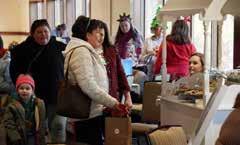



Writer / Michelle T. Williams

It all started with Christmas oranges and pajamas…
Seven and a half years ago on a crisp December day, I sat in my den watching a movie with my then-4-year-old daughter. We were in our holiday pajamas watching “Christmas Oranges” while wrapping gifts. The movie was set in the early 20th century, and the story was about children living in an orphanage. What stood out to me was a scene about a child who did not get her Christmas orange - the only gift she would receive - because she didn’t follow the rules. Something about that scene struck a chord inside of me. I turned to my husband and asked, “Do you think there are children living in orphanages who don’t get presents for Christmas?” He replied, “Wow, I never thought about that before. It would be sad if they don’t get gifts for Christmas.”
The movie made me think about my values. I was taught to lend a helping hand and help those in need. I wanted to figure out
a way to ensure the foster youths in my community weren’t forgotten at Christmas. I thought about my family’s tradition. We open a new pair of holiday pajamas on Christmas Eve every year. I decided to make it my mission to find a way to share my family’s Christmas pajama tradition with foster youths.
By the following July, I had founded Santa’s Little Helpers, Incorporated (SLHI). Our mission is to help build the self-esteem and confidence of foster children by building a foundation of literacy, personal growth and development. Our programs and services are designed to help individuals in the foster care system thrive during and after foster care.
The first program we launched was the CARES Program. This program provided new Christmas pajamas to foster children living in Kentucky residential facilities. In 2020 the program expanded to offer Christmas care packages that include
new pajamas, dental kits, sensory tools and a book. In addition to Christmas care packages, we now provide back-to-school supplies and Easter baskets to those in foster care. Since we opened our doors, we have gifted over 1,300 pajamas to foster children in Kentucky.
The needs of those in foster care extends well beyond pajamas and supplies. Young adults transitioning out of the foster care system need support systems to help them with independent living. We implemented the Future Forward Program to provide transitional services to teens and young adults preparing for life after foster care. We provide workshops and coaching focused on daily living skills, education, employment readiness, health and wellness, and housing security. The purpose of these services is to help individuals progress and thrive after leaving the foster care system.
We are able to offer these year-round programs and services because of the


generous support and dedication of people in our community and our community partners. Each year we host an annual event to raise money for our CARES Program. Our fourth annual Pajama Palooza and Holiday Market will be held on Saturday, November 9 from 2 p.m. to 5 p.m. in the gymnasium of Beargrass Christian Church (4100 Shelbyville Road in Louisville). This event is a great way to kick off the season of giving while spending quality time with those in the community. It will help you get into the spirit of the holiday season and offer fun activities for the family. Get your shopping done early by visiting our Holiday Market with a variety of products from local vendors.
Are you a vendor interested in selling at our marketplace? Contact us at michelle@santaslittlehelpersinc.com or sign up






on our website.
The kickoff of the SLHI Pajama Tree will happen at our November event. If you would like to support a foster child at our Pajama Palooza, you can select an ornament from the tree and drop off the pajamas at any of our drop-off locations. We will also have pajama bins available at the event for you to bring a new pair of adult-sized pajamas. Pajama drop-off locations are Class Act Federal Credit Union branches or the SLHI drop box at John Knox Presbyterian Church (9104 Westport Road in Louisville) from November 9 to December 13. We will be adding drop-off locations later this month on our website at

santaslittlehelpersinc.com.
Kentucky has over 8,000 individuals in the foster care system at any given time. People like you can make a difference in the life of a foster child. You can get involved by donating today on our website or donating new pajamas. Every $25 donated covers a new pair of pajamas for an individual in foster care. SLHI was established to capture some of that Christmas magic for foster kids in our community and make a difference in their lives. Join us in being one of Santa’s helpers this holiday season.
Merry Christmas from SLHI!

Expires 12/31/2024

Expires 12/31/2024












Writer / Beth Wilder Photography Provided
It was called “the war to end all wars,” and thankfully, the Great War that broke out in 1914 Europe was not fought on American soil - but that did not mean Americans were spared the war effort. Even before the United States officially entered the war in 1917, Americans pitched in to help their European Allies in any way they could. Local residents were no exception.
Area residents were fortunate. Aside from rising costs, they did not have to truly worry about the war when it first began. Of primary concern in 1914 was the fact that Christmas toys would have to be homemade, as none of the European countries were able to export any goods. By 1916 paper stock had gotten so expensive that The Jeffersonian editor, J.C. Alcock, feared the cost of his newspaper might have to increase, and insisted that those in arrears make their subscription payments or stop receiving the paper.
On May 25, 1916, a quote from the Germantown News must
have prompted the townsfolk to take the war a little more to heart. Alcock was praised for the great success a special war edition had, although the article went on to muse, “But maybe they are not affected by any of the conditions and calamities of the world’s big war act in that peaceful hamlet.” The next month, three local boys, Leroy Omer, Walter Zerger and Walter Ellingsworth, joined the Navy.
In May 1917 everyone was asked to assemble on the public square, carry the American flag and adorn their automobiles in patriotic colors. From there, the parade of cars drove to the schoolhouse, where over 2,000 people from different parts of the county assembled to hear various speakers urge young men to enlist, rather than wait to be conscripted into the military.
On June 5, 1917, all men between the ages of 21 and 31 were required to register for the draft. On July 26, the first list of draftees was printed in the paper.
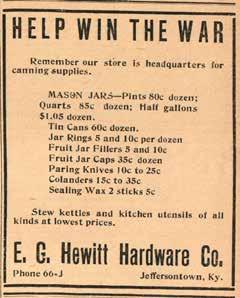
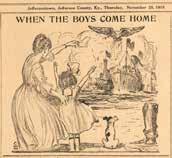

Brother and sister Charles G. and Aileen Bryan were both ordered to France. Charles was commissioned a captain in the Engineer Corps of the United States Army, and Aileen, a member of the Red Cross staff of trained nurses, volunteered for field hospital service.
Those who remained at home in were required to do their fair share toward the war effort as well. In October 1917, a group of more than a dozen local women canvassed the area to ask every householder to sign a pledge card to be as economical as possible, to help ensure those overseas had enough food. A Tobacco Fund was even created, so that “chews” and “smokes” could be forwarded to the fighting men in France.



Men who remained at home were encouraged to become Boy Scout leaders, so the young men in town would have a good influence and not risk becoming delinquents, as was happening in the war-ravaged countries. All boys were urged to join the Scouts, who served as dispatch bearers, delivering government pamphlets to all the local homes. In March 1918, boys aged 16 to 21 were asked to enroll in the Working Reserve, in the hopes that when they were out of school, they would assist with farm work or whatever occupation best suited them.
C.A. Hummel was a local enrolling officer and boys who signed on were eligible to receive a Federal Bronze Badge of Honor for a stated number of work days. Girls were also encouraged to join



clubs that would help with raising food, and several prominent businessmen in town sold liberty bonds.
Meanwhile, residents were forced to tighten their belts. Food production was a priority - home canning and meatless days were encouraged. J.C. Alcock joked that a “taste” of food was about all he got, thanks to the conservation pledge the ladies signed.
Coal was hard to come by. The local paper noted in January 1918 that “every week or two a car load comes in, and is gobbled up before a third of the people get any.”
One particular group that suffered in a slightly different way was the local Germans. East Louisville had a high number of Germans, so a good deal of its populace had that ancestry - and some still retained their loyalty to Germany, especially if they had relatives fighting in the Kaiser’s army. The Jeffersonian newspaper noted that the majority of Germans in the county were loyal Americans, even if some of them did make “disloyal statements in regard to the war,” and that it was not right to say “mean things about the German-Americans because they are from Germany.” By the end of January 1918, however, all non-American citizens were required to officially register. Arch Bridwell, postmaster, conducted the registrations locally.

Red Cross units abounded, of course. Local groups helped sew and knit hospital garments, trench caps, socks, sweaters and more. N.R. Blankenbaker was happy to report his workers had raised $6,325 for the war fund - in today’s money, that would equate to over $43,000. Even children helped raise funds for the Red Cross by putting on shows, and they were also asked by postman Lud Bryan to gather all the plum, peach and prune seeds, walnut shells, and hickory nut shells they could, to be used in the manufacture of gas masks.
Although three million men had already been drafted into service, in September 1918, another two million were deemed necessary. The enlistment notice stated: “Patriots will register. Others MUST.” By the following month, soldiers and civilians alike were fighting a new battle - an influenza epidemic. Nurses were in high demand, and by November, east Louisville was dealing with its highest number of cases to date.
Thankfully, on November 11, 1918, the armistice was signed, ending World War I. Relief was still needed both in the United States and throughout the world though. Residents still had to bounce back from the flu epidemic, but they continued their support efforts through the reconstruction after the devastating war was over, doing their part as proud Americans, happy to have their boys home.










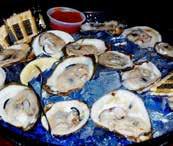












For advertising information, contact:

COREY BOSTON
corey@townepost.com (502) 407-0185
Aril F.
Metastatic Breast Cancer, 2022


At UofL Health–Brown Cancer Center, you’ll find inspiring stories like Aril’s, thanks to our collaborative approach, early detection and pioneering treatments. Here, hope comes to life with our expert second opinions, advanced technology and personalized holistic care. We harness the power of academic research and groundbreaking clinical trials, only found here, to help survivors make more memories and keep living their stories.
Experience the power of world-class care, close to home at our three Louisville locations.
THAT’S THE POWER OF U

To find Aril’s story and other survivor stories, visit UofLHealth.org/BCCStories.